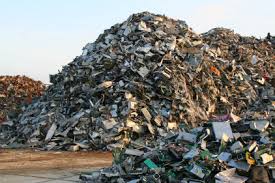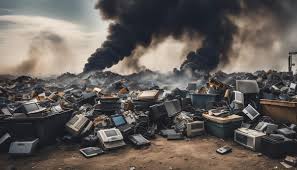
The world generates over 57 million tons of electronic waste annually – enough to bury Manhattan under 100 feet of discarded gadgets. As this toxic tsunami grows, a critical question emerges: Who bears responsibility for the e-waste crisis? This 2,500-word investigation uncovers the complex web of blame, from manufacturers and consumers to governments and recyclers, while exposing the shocking truths behind our broken electronics lifecycle.
A. The Staggering Scale of the Crisis
-
By the Numbers:
-
-
Global e-waste per year: 57.4M tons (equivalent to 5,700 Eiffel Towers)
-
-
-
Recycling rate: Just 17.4% of all e-waste gets properly recycled
-
-
-
Toxic impact: Each year, e-waste releases 50 tons of mercury into the environment
-
-
-
The Hidden Contents of Your Trash:
-
$57B in recoverable metals discarded annually
-
7% of the world’s gold may be trapped in e-waste
-
100+ toxic substances found in typical electronics
-
B. The 5 Primary Culprits
1. Manufacturers (The Planned Obsolescence Problem)
-
Design Crimes:
-
Non-replaceable batteries in 92% of smartphones
-
Proprietary screws preventing repairs
-
Glued components instead of modular designs
-
-
Statistical Evidence:
-
60% of device failures occur within 2 years of purchase
-
Repair difficulty scores have increased 32% since 2015
-
2. Consumers (The Upgrade Culture Addiction)
-
Behavioral Trends:
-
Average smartphone lifespan: 2.5 years (could be 5+)
-
40% of replaced phones still fully functional
-
Black Friday/Cyber Monday upgrade mentality
-
-
Psychological Drivers:
-
“Shiny new thing” syndrome
-
Peer pressure and social signaling
-
Misunderstanding of “slow phone” causes
-
3. Governments (The Policy Failure)
-
Global Regulation Gaps:
-
Only 78 countries have e-waste laws
-
US lacks federal e-waste legislation
-
Developing nations bear 76% of informal recycling burdens
-
-
Missed Opportunities:
-
Tax incentives for repairable designs
-
Weak enforcement of existing laws
-
Lack of standardized recycling programs
-
4. Recyclers (The Dirty Secret of “Green” Programs)
-
Industry Realities:
-
30-40% of “recycled” e-waste gets exported illegally
-
Many programs simply shred devices for bulk metals
-
Only 12 companies globally can properly recycle LCD screens
-
5. Retailers (The Convenience Facilitators)
-
Sales Practices:
-
Push for frequent upgrade plans
-
Discount bundling of unnecessary accessories
-
Zero take-back requirements in most stores
-
C. The Toxic Trail: Where E-Waste Really Ends Up
-
The Global Dumping Grounds:
-
Agbogbloshie, Ghana (world’s largest e-waste site)
-
Guiyu, China (birthplace of informal recycling)
-
New Delhi slums (children dismantling devices barehanded)
-
-
Health Impacts:
-
70% of children in e-waste areas show elevated lead levels
-
20% higher cancer rates in recycling communities
-
Neurological damage from burning PVC cables
-

D. Solutions vs. Greenwashing
Real Solutions Working Today:
-
France’s repairability index law
-
Fairphone’s modular smartphone success
-
Apple’s robot recycling (Daisy recovers 1 ton of gold/year)
Corporate Greenwashing Examples:
-
“Eco mode” that barely saves energy
-
100% recycled packaging (while device remains unrecyclable)
-
Carbon neutral claims based on questionable offsets
E. What You Can Actually Do
-
Extend Device Lifespans:
-
Battery replacement instead of new phone
-
Linux for old computers
-
Repair cafe movements
-
-
Responsible Disposal:
-
Certified e-Stewards recyclers
-
Manufacturer take-back programs
-
Data destruction best practices
-
-
Voting With Your Wallet:
-
Right to repair supported brands
-
Modular electronics
-
Refurbished market purchases
-
F. The Future Outlook
-
Positive Trends:
-
EU’s common charger mandate
-
Growing refurbished market ($140B by 2030)
-
Right-to-repair legislative wins
-
-
Ongoing Challenges:
-
IoT devices complicating recycling
-
EV battery wave coming
-
Space junk becoming orbital e-waste
-

Conclusion
The e-waste crisis represents a collective failure of epic proportions, with blame distributed across corporations, consumers, and governments alike. While manufacturers engineer disposable products and governments drag their feet on regulation, consumers fuel the fire through upgrade addiction. Breaking this cycle requires radical transparency, true product stewardship, and a fundamental rethinking of our relationship with technology. The solution begins with recognizing that there’s no such place as “away” when we throw our gadgets “away.”














